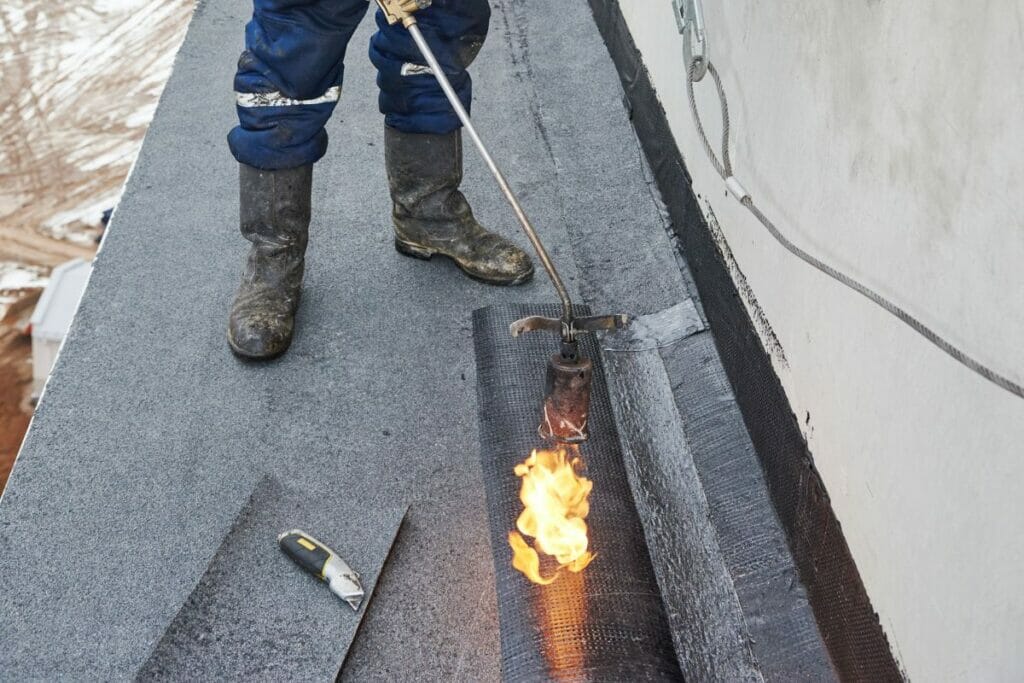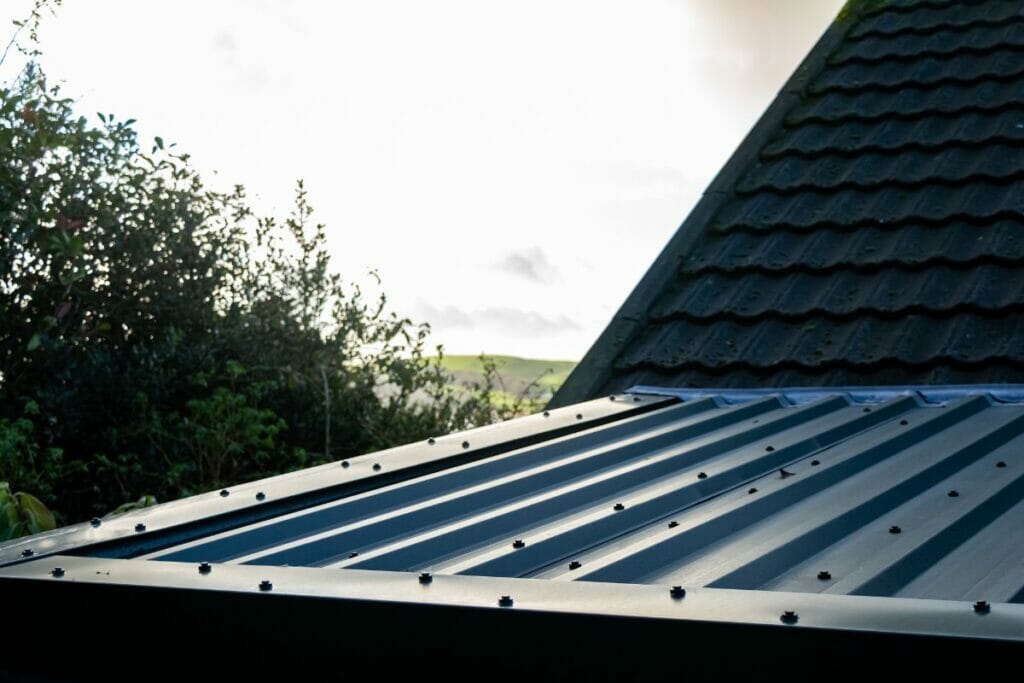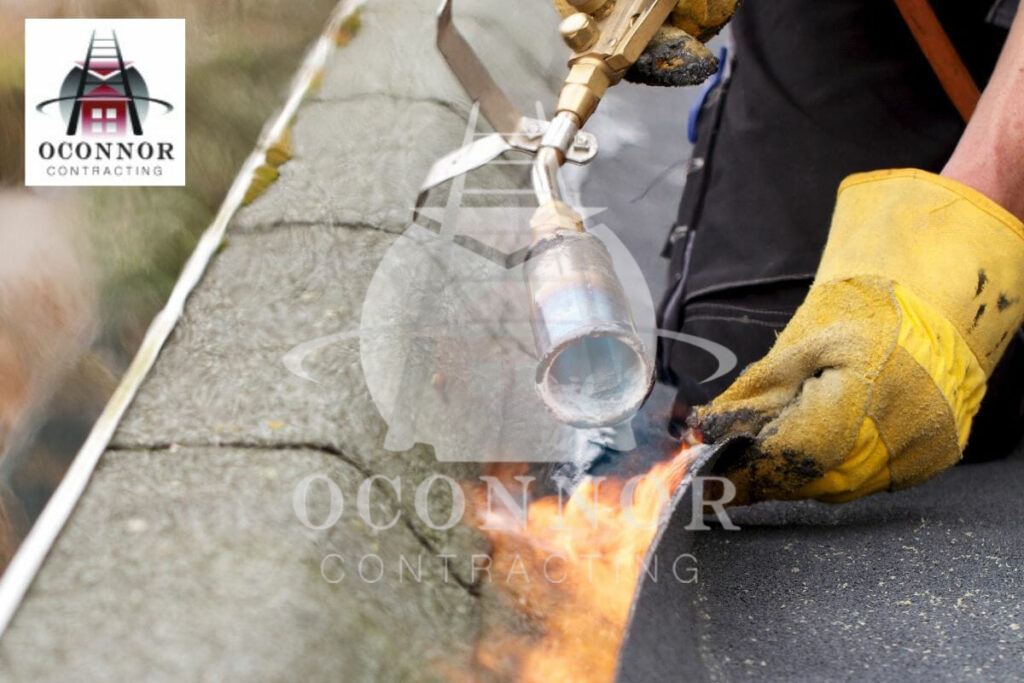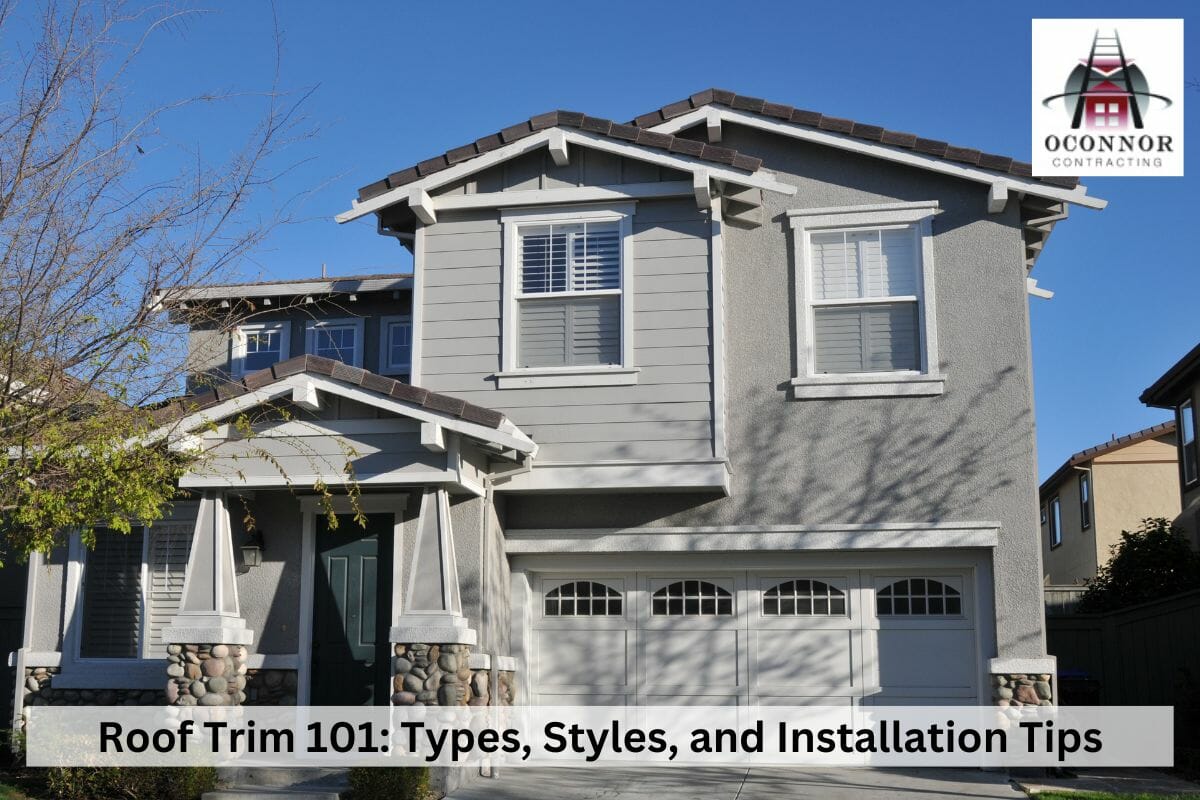Flat roofs are versatile, affordable, and a great way to cover the exterior parts of your home, such as a garage, porch, and shed. But with their benefits come some unique challenges, particularly leaks. To repair flat roof leaks, homeowners should know some crucial facts about the repair approach.
At OConnor Contracting, we’re here to help you get started with the solution. In this blog post, we’ll explain the details of repairing leaks in different types of flat roofs and fixing the root causes of the issues for good.
Flat Roof Leaks: Causes and Solutions
Flat roofs are made of various materials, including modified bitumen, metal, and single-ply membranes such as TPO and EPDM. We will explain different signs of leaks based on different roofing materials, the root cause of such issues, and possible ways to fix them.
Single Ply Roofing Systems
EPDM, TPO, and PVC membranes have different compositions, but the signs of leaks are generally similar with all three materials.
#1 Blisters or Bubbles on the Membrane’s Surface

Blisters and bubbles can be caused by moisture getting trapped between the membrane and the layer of insulation. This can weaken the roof and lead to leaks. Blisters generally form due to frequent temperature fluctuations, heat, and UV rays.
> The repair options for a blistering membrane generally include cutting out the affected area and replacing it with a new membrane.
#2 Cracking or Splitting of the Membrane
Single-ply membranes are sturdy but often crack and split because of prolonged exposure to extreme weather conditions or foot traffic on the roof.
> The solution to repairing cracks and splits requires installing a big patch over the cracked surface and sealing it tightly.
#3 Punctures or Holes in the Membrane
Punctures or holes are usually a result of impacts from foot traffic, flying debris, or heavy objects. This is common in areas prone to wind and hailstorms.
> You can patch a few holes, but if there are multiple punctures or significant gaps, repairing your leaky flat roof might not be enough. The right solution is to replace the membrane.
Modified Bitumen Roofs
Modified bitumen roofs are known to be sturdier and more durable than single-ply roofs. However, leaks are common with both types of flat roofing systems.
#1 Alligatoring
Modified bitumen roofs can develop cracked lines along their surface due to UV rays and heat exposure, causing leaks. This is also called alligatoring, as the cracks look like the skin of an alligator.
> Alligatoring along the surface of modified bitumen roofs can be repaired by installing a suitable coating over the existing roof.
#2 Separated Seams
Seams are critical to the integrity of a modified bitumen roof. Over time, the seams split or separate from the roofing system due to aging, weathering, or poor installation. This can allow water to penetrate the surface and lead to leaks.
> Depending on the extent of separation, the seams may need to be resealed or repaired to prevent further damage.

#3 Depressions or Low Spots Along the Roof’s Surface
This can occur due to several factors, including aging, poor installation, or foot traffic. Depressions allow water to pool on the roof and increase the risk of leaks.
> It may be feasible to repair the area by filling it with modified bitumen or covering it with a patch of sealant to prevent further damage.
#4 Ponding Water
Modified bitumen roofs require proper drainage to prevent water from accumulating and causing damage. Ponding water leads to leaks and accelerates the aging of the roofing material. Ponding occurs when debris accumulates in the drains, or the drains are installed improperly. In this case, it is crucial to inspect the roof’s entire drainage system and address the issues accordingly.
> The solution may include cleaning the roof and drains or replacing the damaged drainage system.
Flat Metal Roofs
Metal roofs are more durable and sturdier than single-ply and modified bitumen roofs. However, they are not immune to damage caused by improper installation, inferior materials, or harsh weather conditions.
#1 Rust or Corrosion on the Roof’s Surface
Metals like steel and iron are prone to rust if they are not protected with a rust-free coating or paint. Rusting occurs due to exposure to moisture in the air, especially in areas with high humidity.
> The rusty areas should be thoroughly cleaned and treated with a rust inhibitor or a metal roof coating. In severe cases, the damaged panels may need to be replaced.
#2 Loose or Missing Screws and Fasteners

Over time, screws and other fasteners used to secure the metal panels may become loose or fall out, allowing water to seep through the gaps.
> To repair flat roof leaks caused by this issue, the loose or missing screws will have to be replaced, and the surrounding area should be inspected for water damage.
#3 Damaged Flashing
Flashing is a piece of metal installed around vents, chimneys, and other gaps to seal and waterproof the roof. Improper installation, reusing old flashing strips, or harsh weather conditions can cause the flashing to dislodge or become damaged, allowing water to seep in.
> It is essential to reflash roofing components like vents and chimneys by using new flashing strips as soon as possible.
#4 Deteriorating Sealant
The sealant used to seal the seams and joints between metal panels may deteriorate over time due to exposure to UV rays and fluctuating temperatures.
> The solution includes removing the ruined sealant and resealing the metal panels using a better-quality adhesive.
When it comes to flat roof leak repairs, homeowners need to be careful and think about long-term solutions. Each repair option has its own benefits and limitations, so it’s essential to choose the one that solves the problem for good.
Understanding the Flat Roof Repair Options in Detail
When it comes to roofing, safety is the most important factor. If you aren’t hiring a licensed professional for the job, it may affect the manufacturer’s warranties and your insurance claim process. Moreover, an improper or temporary fix will never solve the real cause of leaks. It only leads to higher expenses later on. That’s why working with a licensed and experienced flat roofing contractor is essential to get the best results.
If you’re ready to start with repairs, here are some crucial details about each repair option:
#1 Patching and Sealing
This is an excellent way to repair a small cut or puncture in the flat roof. There are flat roof leak repair sealants and patches that quickly and inexpensively address the problem. It’s a simple solution that can be done by homeowners or professionals, and it helps extend the life of the roof.
#2 Roof Coatings
A roof coating is a long-term solution to repair flat roof leaks. A high-quality roof coating can improve the energy efficiency of the building and prevent leaks. There are different types of coatings available, including acrylic, silicone, and polyurethane. The right coating depends on factors such as the climate, the type of flat roof, and the amount of foot traffic the roof receives.
#3 Roof Membrane Repair
A damaged membrane requires a more extensive method of repair that is ideal for fixing leaks caused by storm damage. There are several flat roof leak repair products designed to repair larger leaks or more severe damage. A professional roofing contractor will cut out the damaged section and replace it with a new membrane, which is then sealed and adhered to the existing roof. This repair option is more expensive than patching and sealing but is a better and more durable solution.
#4 Roof Replacement
Flat roofs can last between 20 to 50 years, depending on the type of material and the quality of installation and repairs. When a flat roofing membrane is older than 18 years, or the damage is beyond repair, a replacement may be necessary. In the case of metal panels, replacing only the damaged panels may solve the problem.
A new flat roof can also improve the energy efficiency of a space and provide better protection from the elements. While replacement is the most expensive option, it is also the only way to ensure you’ll have zero flat roofing problems for up to 10 years or more.
If you want to understand how much you might have to pay for repairs, let’s understand the factors that go into the cost.
Understanding Flat Roof Leak Repair Costs
Understanding the repair costs is vital for homeowners who want to ensure they’re getting a fair price for the work being done. Your flat roof leak repair cost can be anywhere between $300 to $1,100. The cost depends on several factors, including the underlying problems with the flat roof, the type and extent of damage, the materials and labor required, and the property’s location.
- Single-ply flat roofs are typically less expensive to repair than modified bitumen or metal roofs.
- Patching and sealing require minimal materials and labor, while the replacement of a roof membrane is more labor-intensive and requires more materials, adding to the repair cost.
- Labor and material costs vary depending on where you live, so it’s essential to get a free quote from contractors before signing any contracts.
If you live in Western New York and are looking for a reliable flat roof leak repair service, we can help you.
Get a Free Estimate on Your Flat Roof Leak Repair Service
At OConnor Contracting, we understand the importance of having a safe and secure home. If you’re dealing with a leaky flat roof, it can be stressful. That’s why we are dedicated to helping homeowners by providing free quotes and consultations. Our experts take pride in delivering high-quality and affordable flat roof repair services that ensure the longevity of your roof. Call us at (716) 600-7663 and discuss your roofing problem with one of our experts.




